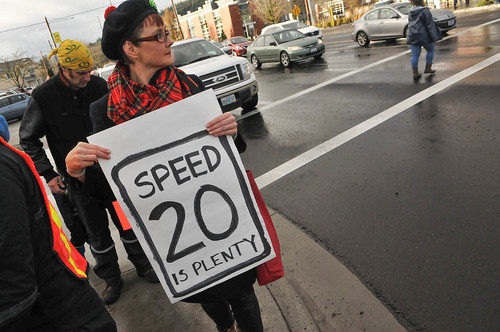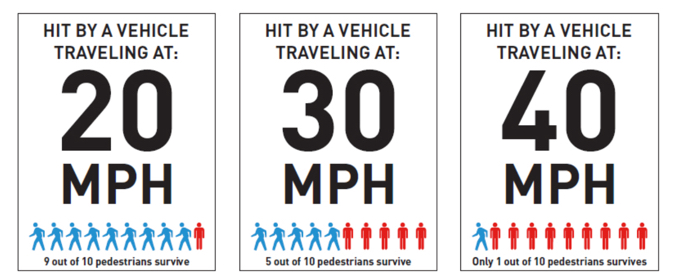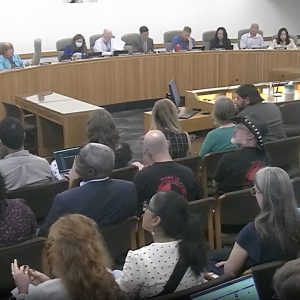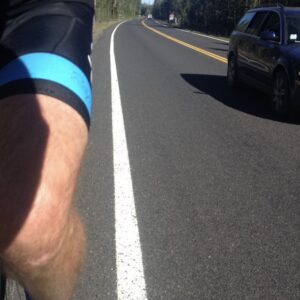
(Photo: J. Maus/BikePortland)
A new state law that would allow the City of Portland to reduce speed limits on over 3,000 miles of residential streets — that’s over 60 percent of all the streets in Portland — to 20 mph cleared a major hurdle yesterday.
With a vote of 4-1 in the Senate Committee On Business and Transportation, House Bill 2682 now only has to pass a vote of the full Senate before it can be signed into law. The bill passed the Oregon House 55-1 back in April.
The bill, sponsored by State Respresentative Rob Nosse, would only apply to the City of Portland. It was amended after cities and counties across the state said they didn’t want the added resonsibility of making speed limit decisions themselves and would rather have ODOT’s continued oversight.
At a hearing prior to the committee vote yesterday, City of Portland Active Transportation & Safety Division Manager Margi Bradway told legislators that with an increasing volume of cut-through traffic (thanks in large part to traffic apps like Waze and Google Maps), this law is needed now more than ever.
Advertisement
“When I think about residential streets, I think about people walking their dogs, playing with their kids… it’s really important we send a message.”
— Margi Bradway, Active Transportation & Safety Division Manager at PBOT during testimony in Salem yesterday.
“When I think about residential streets, I think about people walking their dogs, playing with their kids. My kids like to ride their bikes and little scooters in the street,” Bradway tesified. “And as Portland gets more crowded unfortunately we’re seeing more cut-through traffic on those streets so it’s really important we send a message by lowering the posted speed limit and keeping those residential streets safe for familes and kids.”
Residential streets currently have a default maximum speed limit of 25 mph. Bradway explained to Senators that even at these relatively low speeds, five miles an hour can mean the difference between life or death. “If a person driving a car hits a pedestrian at 25 mph they are 42 percent more likely to kill that person than they are at 20 mph. That’s a big jump.”
A representative for the Asian Pacific American Network of Oregon also testified. Several fatal collisions in 2016 happened just blocks from their offices on SE Division Street. “Too many of our community elders have been killed crossing the street. We believe these deaths are preventable… slower speeds may have saved their lives.”
While this new law wouldn’t give PBOT the ability to lower speeds on arterials like Division, they can still use other tools to tame traffic on larger streets. Bradway said this is a “good compromise” with ODOT, who wasn’t comfortable giving PBOT authority over arterials because of the presence of freight vehicles.
The Street Trust and Families for Safe Streets both wanted the bill to include arterials. In a written statement submitted to the committee, The Street Trust wrote, “We also would like to see this bill go further in allowing the City of Portland and other jurisdictions to also lower speed limits on arterials and other high-speed streets, including those designated as high crash corridors.”
The lone Senator who voted against HB 2682 was Fred Girod, who represents a rural district east of Salem. Girod said he thinks enforcement is more important than speed limits. He also said he doesn’t like how Portand is being “separated out” and that if Portland wants to reduce deaths on arterials they should take jurisdiction of them away from ODOT.
The bill now moves to a vote of the full Senate.
In other legislative news: Senate Bill 493, which would create a new crime of criminal negligence with a motor vehicle, has passed the House. And the distracted driving/cell phone bill, HB 2597, is scheduled for a hearing and possible Senate vote tomorrow (5/24).
— Jonathan Maus: (503) 706-8804, @jonathan_maus on Twitter and jonathan@bikeportland.org
BikePortland is supported by the community (that means you!). Please become a subscriber or make a donation today.







Thanks for reading.
BikePortland has served this community with independent community journalism since 2005. We rely on subscriptions from readers like you to survive. Your financial support is vital in keeping this valuable resource alive and well.
Please subscribe today to strengthen and expand our work.
Good news!
In NYC when the default speed was increased to 25MPH from the existing 20MPH the police chief admitted he would have to arrest half the city’s drivers if it was done. Of course Portland isn’t NYC but you might have a bit of resistance unless the drivers are enticed to follow the change.
I see this new rule applies only to 60% of roadways in Portland, meaning 40%(the through-streets) are what 25MPH or more? NYC in the beginning set “the default speed” at 25MPH meaning all streets. Pictures were take and glad-handing was done. The 30MPH speed signs were removed and only later to be restored. Some of those through streets had to be jacked back up to 30/35/30/45MPH. Very disconcerting.
I remember seeing Jeff Fleck on C-SPAN with criticism of both Portland & NYC and its “improvements”. Bike Lanes at the curb were a bad idea. He also didn’t believe the NYC biking numbers. Big estimates but he couldn’t ever see them on the streets.
Um, that’s kind of what we have been trying to do. It would be awesome if people didn’t have to die because of ODOT’s incompetence, so if Fred could go ahead and help Portland, and every other city so that we’re not being “separated out,” show ODOT the door that would be great.
Actually, Portland already controls almost all Federally classified Arterial streets in Portland.
Rural representatives may not be aware of this fact, since their big roads are usually state controlled.
First good news I’ve read all day!
This is great, but we need enforcement! I live on Lincoln, which is currently posted for 20 mph, and I would guess that a majority of drivers are traveling faster than that.
Have you or your neighbors planted some more street trees?
Agree – there’s a lot of speeding and passing bikers with little room on Lincoln and Salmon. All greenways should have barriers preventing car access like on Clinton and Ankeny – anyone know if there’s been a push for that?
Diversion by Default on Designated Neighborhood Greenways will be a great way for Portland to take back it’s reputation as a cycling leader.
Neighborhood associations and activists have been pushing for diversion on Salmon and Lincoln-Harrison. PBOT listed Lincoln-Harrison as a priority but I’ve not heard much about this lately.
Yes, many neighborhood associations are supportive of cycling.
I live on N Concord Ave. Same problem here.
Here’s an idea. You’d probably need at least yourself and ideally another neighbor across the street being OK with giving up your on-street parking (or maybe just making it less convenient), but creating a chicane like this would be a heckuva lot more effective than street trees. I’m thinking about pushing something like this on my problem street segment (103rd between Harold & Foster).
https://bikeportland.org/2017/04/21/how-i-worked-with-pbot-to-build-a-play-street-in-my-neighborhood-225869
I’m like a broken record on the same subject. Why do the State and municipalities pass laws that they have no ability, or intention of enforcing? 20 mph is probably too slow in most neighborhoods for efficient travel, and 25 would be just fine, if it was enforced. I would guess the average speed is around 30, except at commute time, when 35 is probably closer to reality. 35 is not only dangerous on narrow streets, but makes the whole neighborhood threatening and unpleasant. I live in Bend, where ‘cut through’ traffic is becoming endemic. You can almost see if happen, as the city grows, and the infrastructure does not. Streets that had almost zero cut-through five years ago, now have one, two three or more per minute now. It dramatically changes a neighborhood. We need more speeding cameras. How expensive would it be to have a camera attached to one of those rolling ‘You are going X mph) displays?
Cut throughs have also been made worse by live updating street maps like Google Maps, advising drivers to cut through residential streets. (I routinely can hear Google or Siri speaking through the speakers of cut through drivers, narrating directions….)
Ability and intention are not the same. PPB may not have the current ability, but it is debatable if City Council does not have the intention.
First, you can’t begin to enforce a law that does not exist. It’s not even a chicken-egg thing.
Secondly, local roads are for connecting private property to higher order streets, not ‘efficient travel’.
Third, it’s a vision zero thing. Lower speeds equal fewer severe injuries and fatal crashes.
While I agree there needs to be a minimum level of enforcement – seems you do too – the form of the enforcement is controlled by the State Legislature.
Lincoln has not had the full neighborhood greenway treatment yet, stay tuned!
And Salmon desperately needs to be upgraded to current greenway standards. Diverters!
Queue the pearlclutchers who are constantly whining about 20 mph being an undue hardship..
Yes. Cue them (unfortunately) but I’d love to also queue them.
Yes ! So cool ! Next step is more enforcement !
Enforcement.
And Willamette. Willamette with smaller lanes, numerous curves, no buffer, on street parking, lots of wide fast exists, kids crossing for school and parks, UP students getting struck by cars, and a significant chunk without bikes lanes (thanks a handful of neighbors) is still 35 mph compared to Rosa Parks 30 etc. Cause why? Given how important Willamette is to the growing number of commuters and the long-standing weekenders, I don’t understand why more folks are not pressuring on this. Lowering Willamette has been on PBOTs radar for some time now. Maybe in my life time.
I ride N Willamette twice a day and it’s always the most uncomfortable part of my 25 mile commute. I’ve actually witnessed drivers pass slower traffic (i.e. people actually obeying the speed limit) on that stretch of road numerous occasions. Dropping the speed limit there even by 5 mph would make a difference, especially given the daily car-on-car violence that goes down there. The piles of broken car parts that litter the bike lanes are getting a little out of hand.
Agreed. Contact PBOT. Ask how you can help move lowering Willamette’s posted speed limit along.
Willamette has two parts. the part with bike lanes north of Rosa Parks, and the part without, south of Rosa Parks. Please clarify.
Willamette north of Rosa Parks to Richmond, has already been requested to the state to change to 30 mph.
Willamette has many parts. I’ve requested the part south of Rosa Parks become an official greenway. This stretch is heaven without cut-through traffic (growing again): amazing views, calm, smiles, waves… I’d argue the best piece of any bike commute anywhere in Portland. Sadly, I’ve been nearly right hooked at the no-right-turn for cars too many times and drivers diverting Greeley can make some mornings intense.
Changes are coming.
The Northern part, where drivers consistently do 40+ miles an hour.
Travis,
I agree- the north segment of Willamette and Skidmore between Michigan and 7th are such notorious gaps!
That segment of Skidmore is not eligible for 20 mph. It’s a collector and fire route. It’s also not a neighborhood greenway, and would need parking removal and bike lanes, as was done near Interstate Ave.
This is great. Now Portland can have 20mph limits both on residential streets and in business districts.
Wish we could get this kind of sense in Minnesota. We have 30mph limits on both residential and business-district streets. And our residential streets are actually slightly narrower than Portland’s.
Not to be picky Jonathan, but (unless she’s recently moved) Sarah I. technically lives in SE (Mt. Scott-Arleta), not East Portland)
I believe Sarah moved to east portland.
This isn’t 100% on topic, but I just needed to vent that I’ve had a spate of encounters with aggressive drivers recently that I haven’t dealt with in the past. I think people are more and more frustrated with the bad traffic, and are taking it out on slower moving bikes.
Yesterday I was almost hit twice in a 10 second span with my two year old on the back of my XtraCycle as I took the lane on Alberta for like 100 yards in order to cross over I-5. This is people purposely driving aggressively, not inattentiveness, and if a woman with a baby on the back of her bike is taking this kind of abuse I shudder to think of what others are faring.
Well, a 60 mph yellow Honda S2000 sports car yesterday on the bikeway SW Jamieson Road, a former trolley corridor. 25 mph road.
Is the increase in bike hate this year greater than the usual up-tick as the weather gets nice? I always interpreted it as motorists going out for more joy-driving who have forgotten that life isn’t a car commercial and thus get easily frustrated. After a month or two of nice weather, they usually seem to calm back down to their usual level of homicidal hostility.
It’s truly awful right now, with these first few days of “summer” weather. I hate the drivers/riders of every motorized thing on wheels. Where did all these crazy aggro people come from???
California.
Yes! I can vouch that it’s worse. People are really angry out there, and cyclists are a soft target, easily identifiable by newcomers from car-dominant places as something different from what they’re used to that is therefore probably causing all the trouble. I’m hearing a lot of drivers yell various versions of ‘you’re not a car!’ out their open windows. Is anyone else getting that? There doesn’t seem to be any connection to how fast I’m traveling when I get it, either – people seem just to be offended by seeing me on the road at all, even if I’m keeping up with traffic.
Audrey’s account of her experience made me shudder – all too familiar these days. Like any form of unearned power, driving a car seems to bring out the worst in people.
No impulse control amongst so many Portland drivers anymore–it’s so dangerous out there for cyclists and pedestrians…and drivers!
Ironically, I’ve always considered Portland drivers especially chill compared to their counterparts elsewhere. Sure, there are bad ones here and there, but they’re considerate and mellow as a group.
I sometimes complain they’re too considerate and wish they’d be more assertive since they yield to me when they shouldn’t which needlessly delays everyone while being more dangerous even if the good intentions are appreciated. It’s best if everyone just obeys the rules of the road.
We still have those – I think of them as the mesozoic era Portland drivers. The aggros (as a noticeable group) are very new – I’d say just in the past year or so.
My perception has been that drivers have been getting more aggressive in the past year, particularly in certain locations.
I’m also seeing drivers getting more assertive. This is a good thing since the roads are safest and fastest if everyone takes and gives when they should.
After being hit from behind by a truck last year, I don’t think kids should be carried on bikes, or in trailers, until they have the ability to consent. I know that is a fatalistic statement, but the streets in most of our cities are too dangerous for young humans, unable to control their own fates.
You can literally say the same thing about cars.
If it makes you feel any better, he verbally and enthusiastically requests to ride the “big big bike” on a daily basis. But yeah, children can’t really consent to anything, it’s up to us as parents to do the best we can. For my family that includes a low-car lifestyle.
Agreed! I feel far better about putting my kid on a bike or walking with her than I do strapping her into a car. Car crashes are the leading cause of death of children over the age of one.
Unfortunately, in the city I feel a lot safer having my son in a car seat than on the tag-along if we are hit. It actually affects my decisions at times, and it pisses me off.
How many of those car crash deaths happened in a crash while properly restrained in a car seat in a city? I have looked at the data from 1975 to 2015 and couldn’t see it teased out.
Yeah, some busybody do-gooder already tried that and we shut him down right quick. It’s a terrible idea that would take bikes off the street and add cars. My family would have been forced to become a 2 car family. Stats show that more bikes and peds, the safer streets become. You’re de facto advocating for more dangerous streets.
http://www.oregonlive.com/portland/index.ssf/2011/01/oregon_bicycle_enthusiasts_in.html
http://www.thedenverchannel.com/news/local-news/cu-study-finds-more-bicycles-on-the-road-lead-to-fewer-accidents
A moment of sanity and a step in the right direction.
Not quite.
Part C of the new section 11, first sentence, includes the word ‘and’ for where to post the speed limit sign. This means that each road that PBOT desires to be posted 20 mph has to have a new sign at each major intersection to inform motorists they have entered a 20 mph street.
If that ‘and’ were an ‘or’ a few dozen signs entering the City, and maybe a few dozen more scattered about to remind people driving stating “20 MPH UNLESS OTHERWISE POSTED” would achieve a blanket residential speed 20.
The law, as currently written, will require hundreds, if not thousands of new signs, especially since most residential streets currently have no posted speed limits.
The citizens of Portland cannot afford all those new signs (sign+post =$150 each), let alone the added maintenance cost and clutter.
It would have been simpler to just change the statutory residential speed limit to 20 mph statewide. This would have meant the neighborhood greenways could have been reduced to 15 mph in tandem, since they are already allowed to be 5 mph below statutory per section 10 of the current ORS.
I thought PBOT’s solution was to post the new 20mph limit signs at every point a road crosses a border of the city. That becomes a hell of a lot of signs, but far fewer than doing it precisely as written. That won’t fly?
If the street is not posted, the city has not complied with the law. This law, as written, is specific in posting each street, though, in keeping with much of ORS, is also sloppy. Consider ‘each end’ of your favorite local street, literally.
The bill would insert this language
“(11) The City of Portland may establish by ordinance a designated speed for a highway under the jurisdiction of the city that is five miles per hour lower than the statutory speed. The following apply to the authority granted under this subsection:
(a) The highway is located in a residence district.
(b) The highway is not an arterial highway.
(c) The city shall post a sign giving notice of the designated speed at each end of the
portion of highway where the designated speed is imposed and at such other places on the highway as may be necessary to inform the public. The designated speed shall be effective when signs giving notice of the designated speed are posted.”
The phrase “and at such other places on the highway as may be necessary to inform the public” does not necessarily mean that a street needs a 20 mph sign at every major intersection. That’s for lawyers to argue about.
3 step solution. Lower the speed limit on residential streets. Allow cyclists to turn in speeders cars specially,using electronically registered and calibrated go pro type cameras. After two infractions the speeders cars have mandated governors installed that limit them to 20 mph everywhere. That way we do away with the hassle of figuring out who was driving the car. I would guess after their first trip to Roseburg on I5 going 20 they will rethink their careless behavior
Thank you for this suggestion. I love it dearly and will have a subtle smile all day as I think of it.
Heck, if they’d let me submit citations using a radar gun, I’d be happy to hang out on the street an hour a week to make it happen, and I suspect my neighbors would be glad to take turns. The funny/sad part is that parents driving kids to Richmond are some of the worst offenders…endangering the parents that walk their kids to school.
Loathe that army of SUVs…
Hear, hear!
Yeah, why does it take a certified law enforcement officer to run a radar gun, and testify in court? If we could change the laws so it becomes ‘just another job’ for someone to be properly trained, properly supervised, and work for $20 an hour on their local streets, we could take a big bite out of speed.
Now the next step…creating legislative permission to lower school zone speeds [were appropriate] to a 15 mph…similar to cities back east…and other places.
Plus, actually *using* the school zone law (here’s looking at you, PBOT – no request made to ODOT re: Powell at 26th (Cleveland High)
Oh, but that would be interfering with the road’s primary use as a giant truck and commuter dump. And “I gotta get to Division Street for the STUFF” all day, all night dump.
PBOT does not typically post school speeds at high schools, or where playgrounds are physically separated from the roadway.
“PBOT does not typically post school speeds at high schools”
Well, why not? Other road authorities in the state do this.
Agreed. In MT, I think the school zone speed limit is 15mph.
It is perhaps worth remembering right about now that it was Ivan Illich who first identified 15 mph as a crucial speed threshold –
“From our limited information it appears that everywhere in the world, after some vehicle broke the speed barrier of 15 mph, time scarcity related to traffic began to grow. After industry had reached this threshold of per capita output, transport made of man a new kind of waif: a being constantly absent from a destination he cannot reach on his own but must attain within the day. By now, people work a substantial part of every day to earn the money without which they could not even get to work. The time a society spends on transportation grows in proportion to the speed of its fastest public conveyance. Japan now leads the United States in both areas. Life-time gets cluttered up with activities generated by traffic as soon as vehicles crash through the barrier that guards people from dislocation and space from distortion.”
https://worldstreets.wordpress.com/2010/09/29/energy-and-equity-ivan-illich/
Great news. However, it’s disappointing that this bill does not include collector streets, since those are the most dangerous to walk on and cross. Additionally, nothing will change once the speed limit is dropped because PBOT won’t re-engineer all the streets to encourage slower speeds. This is a good start though.
Dammit. I guess SE 26th is out, then? It’s getting way dangerous over here.
Actually, Section 11, as written, has only three caveats:
a) … located in a residence district
b) …not an arterial highway.
c) posting…
City policy would then dictate where to apply.
https://olis.leg.state.or.us/liz/2017R1/Downloads/MeasureDocument/HB2682
Hmmmmm!
But…we’re already 25mph on SE 26th. And rare is the driver who obeys the speed limit here.
We on the westside of Vancouver are seeing the steep increase in regional “rat-running” on local arterials guided by dynamic social traffic apps, as Portland commuter traffic hops off of I-5 onto Columbia St (Main St, etc.) to slingshot around stalled traffic before hoping back on I-5 at 5th Street ramp. Time to retime the traffic signals to break up these platoons of traffic vs. the “green wave” for peak traffic. Then apps like Waze will recalibrate the routes back onto the interstate/ state routes…etc.
…Similar to what CoP “Active Transportation & Safety Division Manager Margi Bradway told legislators that with an increasing volume of cut-through traffic (thanks in large part to traffic apps like Waze and Google Maps)”
I hear 31 is the new 20.
Worthless without enforcement.
It is fun to wring our hands about the lackluster commitment to speed enforcement around here – I’ve engaged in it myself. But I wonder if we couldn’t be more constructive if we first figured out
– how other communities have gone about this?
– whether it was money or staff or priority or strategy that made the difference?
I only know of one proximate community (that is incidentally completely different than Portland) that figured this out (and I’ve mentioned them here before): Amity, OR on Hwy 99W. Without having interviewed the authorities there my impression is that they decided to try a zero tolerance policy, put staff on it, and achieved a collective shift in attitude toward posted speed limits as no-nonsense, consequential pieces of official communication. How much this cost, how long it took for the message to register (they don’t to my knowledge do much enforcement today though I could be wrong about that), whether their experience has lessons for a place as big as Portland/ Multnomah County I don’t know. But someone (who takes Vision Zero seriously) should be looking at this, taking the challenge of enforcement seriously rather than constantly passing the buck, equivocating.
And with enforcement being the current cruel joke that it is in this town, this will mean next to nothing. My broken record is that my neighbors and I have called for years for enforcement on our 20mph Greenway and have gotten nothing. We have morning commuters doing 40mph down our street, 2 blocks from a school and just forget it. Nothing. 823-SAFE is the beg-button of help lines. It makes people feel better for having called, but that’s it.
A 20 mph Greenway with traffic going much faster than that, and drivers bypassing the diverter with regularity. And all we got was a single 1/2 hour enforcement (6?) years ago when they first installed the diverter. Since then, despite dozens of calls? Nothing.
It’s a joke.
If you’re brave enough to name the street, everyone can look up your ‘speeding problem’.
The next step in traffic control has to be to cut down the ability of through drivers to cut through residential areas. In the city I grew up in (Canberra), the streets were laid out from the 1950’s with the expectation that cars would dominate, and that through traffic needed to be kept out of residential streets. Obviously we’re not going to be replatting Portland’s streets, but what we can do is break up the grid so that it is not possible for motor vehicles to pass, but it is possible for pedestrians and cyclists. For example, when N Williams crosses N Killingsworth, there are planters preventing motor vehicles proceeding north, but cyclists and pedestrians can carry on. More of this kind of action is needed. In my neighborhood, some streets, like N Portsmouth Ave, N Houghton are wider and clearly meant to be main thoroughfares, others, like N Van Houten are narrow and meant to be residential – yet Siri and Google Maps will direct through traffic down N Van Houten to get to N Columbia Blvd.
I think the grid pattern is the worst possible design for residential neighborhoods – it is an open invitation to heavy traffic on every street.
As I understand it, the wider streets in N Portland were built during WW2 to facilitate ship construction.
https://en.wikipedia.org/wiki/Oregon_Shipbuilding_Corporation
Let’s pause for a moment to say “Thanks Margi!”
Thanks, Margi!
Jonathan do you know how PBOT intends to roll this out?